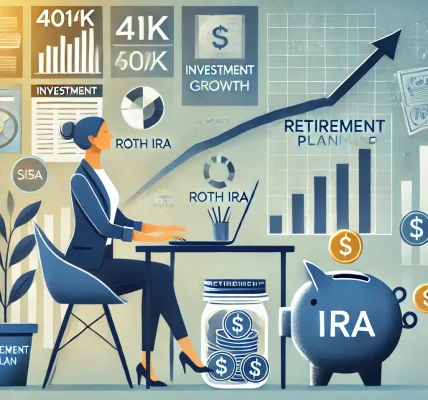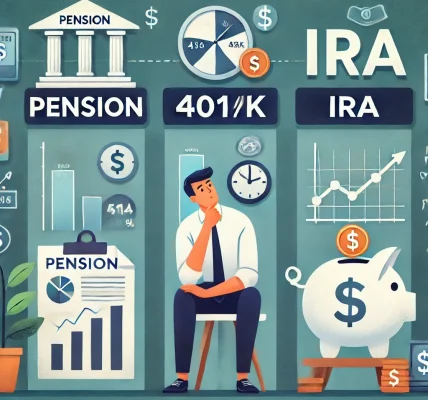Introduction
Planning for retirement is one of the most important financial goals in life. Many people aim to build a retirement fund that provides financial security without exposing their savings to unnecessary risks. While high-risk investments can offer greater returns, they also carry the possibility of losses. If you are looking for a strategy that prioritizes stability, this guide will walk you through the best ways to build a retirement fund with minimal risk.
Why Minimize Risk in Retirement Planning?
1. Protecting Your Hard-Earned Money
- Retirement savings should be safeguarded from market volatility.
- Avoiding unnecessary risk ensures a steady income in retirement.
2. Ensuring a Stable Future
- Secure investments provide predictable returns.
- Reduces stress and financial uncertainty during retirement.
3. Preventing Losses Close to Retirement
- As you approach retirement, recovering from losses becomes harder.
- A low-risk strategy ensures financial security in later years.
Steps to Build a Low-Risk Retirement Fund
1. Start Early and Save Consistently
- The sooner you start, the more you benefit from compound interest.
- Regular contributions help you build a strong financial foundation.
2. Choose Safe and Reliable Investment Options
- Consider low-risk assets that provide steady returns.
- Diversify your portfolio to minimize potential losses.
3. Maximize Contributions to Retirement Accounts
- Contribute to tax-advantaged accounts like:
- 401(k) or Roth 401(k)
- Individual Retirement Accounts (IRA & Roth IRA)
- Simplified Employee Pension (SEP) IRA (for self-employed individuals)
- Take advantage of employer matching contributions.
4. Diversify Your Portfolio with Low-Risk Investments
- Government Bonds: Treasury bonds and municipal bonds offer stability.
- Fixed Deposits (CDs): Guaranteed returns with minimal risk.
- Dividend Stocks: Blue-chip stocks provide steady dividend income.
- Real Estate: Rental properties offer passive income with long-term appreciation.
- Annuities: Provide a guaranteed income stream for retirement.
5. Consider a Balanced Fund or Target-Date Fund
- A balanced fund offers a mix of stocks and bonds, ensuring stability.
- Target-date funds automatically adjust risk levels as you near retirement.
6. Keep an Emergency Fund
- Maintain 6-12 months of living expenses in liquid assets.
- Helps avoid withdrawing retirement savings in case of unexpected expenses.
7. Monitor and Adjust Your Investment Strategy
- Periodically review your portfolio to ensure it aligns with retirement goals.
- Shift towards more conservative investments as you get closer to retirement.
Low-Risk Investment Options for Retirement Planning
1. High-Yield Savings Accounts
- Provides liquidity while earning interest.
- FDIC insured, making it a safe option.
2. Treasury Bonds and Municipal Bonds
- Low risk, backed by the government.
- Municipal bonds offer tax-free interest income.
3. Fixed-Index and Immediate Annuities
- Guarantees a steady income stream for life.
- Protects against market downturns.
4. Dividend-Paying Stocks
- Established companies provide regular dividend income.
- Less volatile compared to growth stocks.
5. Real Estate Investment Trusts (REITs)
- Provides real estate exposure without direct property ownership.
- Generates passive income through rental earnings.
6. Certificates of Deposit (CDs)
- Fixed interest rates with zero market risk.
- Insured by FDIC, making them a safe choice.
Common Mistakes to Avoid in Low-Risk Retirement Planning
1. Being Too Conservative Too Early
- Avoid keeping all funds in cash, as inflation reduces purchasing power.
- Maintain a mix of safe investments for steady growth.
2. Not Diversifying Investments
- Relying on one type of investment increases risk.
- Spread funds across bonds, annuities, real estate, and safe stocks.
3. Ignoring Inflation
- Ensure investments provide returns higher than inflation.
- Consider Treasury Inflation-Protected Securities (TIPS).
4. Withdrawing Too Early
- Early withdrawals from retirement accounts lead to penalties and taxes.
- Follow required minimum distributions (RMDs) after retirement age.
5. Not Rebalancing Portfolio Regularly
- Market conditions change over time.
- Regular adjustments keep investments aligned with retirement goals.
Conclusion
Building a retirement fund with minimal risk requires careful planning and disciplined investing. By diversifying investments, contributing consistently, and choosing low-risk financial instruments, you can ensure a stable and stress-free retirement.
Start early, monitor your portfolio, and adjust your strategy as needed to maintain financial security for the future. With the right approach, you can retire with confidence, knowing that your money is safe and working for you.




